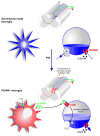Microglia-neuronal signalling in neuropathic pain hypersensitivity 2.0
- PMID: 20817512
- PMCID: PMC3589562
- DOI: 10.1016/j.conb.2010.08.005
Microglia-neuronal signalling in neuropathic pain hypersensitivity 2.0
Abstract
Microglia are increasingly recognized as critical in the pathogenesis of pain hypersensitivity caused by injury to peripheral nerves. The core signalling pathway is through P2X4 purinergic receptors on the microglia which, via the release of brain-derived neurotrophic factor, cause disinhibition of nociceptive dorsal horn neurons by raising intracellular chloride levels. This disinhibition works in synergy with enhanced excitatory synaptic transmission in the dorsal horn to transform the output of the nociceptive network. There is increased discharge output, unmasking of responses to innocuous peripheral inputs and spontaneous activity in neurons that otherwise only signal nociception. Together the changes caused by microglia-neuron signalling may account for the main symptoms of neuropathic pain in humans.
Crown Copyright © 2010. Published by Elsevier Ltd. All rights reserved.
Figures


References
-
- Woolf CJ, Salter MW. Neuronal plasticity: increasing the gain in pain. Science. 2000;288:1765–1769. - PubMed
-
- Davalos D, et al. ATP mediates rapid microglial response to local brain injury in vivo. Nat Neurosci. 2005;8:752–758. - PubMed
-
- Nimmerjahn A, Kirchhoff F, Helmchen F. Resting microglial cells are highly dynamic surveillants of brain parenchyma in vivo. Science. 2005;308:1314–1318. - PubMed
-
- Perry VH. Modulation of microglia phenotype. Neuropathol Appl Neurobiol. 1994;20:177. - PubMed
Publication types
MeSH terms
Substances
Grants and funding
LinkOut - more resources
Full Text Sources

